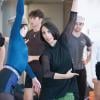
The specter of death arrives early for both heroines in San Francisco Ballet’s two-part program “Broken Love.” But don’t let this cast a pall.
Mortality’s long shadow heightens and intensifies the evening’s drama in strikingly different ways. It happens first with the intensely vivid spectacle of Broken Wings, Belgian choreographer Annabelle Lopez Ochoa’s dark praise song to the life and art of Frida Kahlo, and then with the exquisite, achingly doomed partner dancing in Sir Frederick Ashton’s Marguerite and Armand.
The double bill, which brings back two ballets that appeared on separate programs in the company’s 2024 season, opened Tuesday, April 8, at the War Memorial Opera House. In juxtaposing these works, Artistic Director Tamara Rojo has turned high contrast into expansive coherence. Love, however you look at it, is an act of all-in desperation.

From museum shows to cinemas, refrigerator magnets to opera houses (such as the opulent El último sueño de Frida y Diego, which had a 2023 run at San Francisco Opera), Kahlo (1907–1954) may be the most widely recognized artist of the 20th century. Reductive overexposure is a risk for anyone taking her on, but it’s a peril largely averted here.
Broken Wings, premiered by English National Ballet in 2016, dives right into Kahlo Land. The stage is full of splendiferous costumes and headdresses (designed by Dieuweke van Reij) that reference the Mexican artist’s famous self-portraits and other works. We take in a color-saturated lighting palette by Jim French and a musical score by Peter Salem that’s steeped in Mexican folk idioms and includes a stand-alone song enchantingly performed by Mexican singer Geo Meneses.
Before the phantasmagoric images surge into view, an ensemble of puppet-like skeletons bristles to life atop a tall black box. Later on, when it’s opened, the box becomes the prison of Kahlo’s lifelong pain (first endured in a bus accident at age 18), then the refuge of her art, and finally the image of her transcendent death (here it’s a bit much).

Isabella DeVivo was a magnetic Frida on opening night. In a teasingly triumphant duet with her fellow artist and feckless lover, Diego Rivera (Myles Thatcher in the thankless role of a macho cad), DeVivo’s Frida planted her bare foot on his thigh, tossed him aside like a gunnysack, and zoomed back in for a fleeting kiss. Meanwhile, from time to time, her arm swung mechanically back and forth, like a pendulum counting down the seconds to death. DeVivo clutched at her abdomen as if to rip out the pain, an image made more explicitly visceral in a subsequent scene with the skeletons.
In the end, it’s not so much the lovers’ standoff and its aftermath that linger. Rather, it’s the vision of Kahlo’s ardent paintings — of birds and rustling leaves and one haunting, quizzical Female Deer (danced by Jihyun Choi). This is Kahlo’s self-portrait The Wounded Deer peering out at us before trotting away.

In Ashton’s Marguerite and Armand, roles created for the famed duo of Margot Fonteyn and Rudolf Nureyev in 1963, the lovers are fated from the start. Marguerite’s got consumption and an arrogant stiff of a family-sanctioned suitor (Nathaniel Remez as the Duke). All she wants is to live for the moment with the lover whose face she sees projected in the giant white swag of Cecil Beaton’s austere metallic set.
In a series of beautifully realized pas de deux, Misa Kuranaga and Joseph Walsh, both splendid, embodied the entire course of a fated love affair. Acting from their feet to the tips of their fingers, the pair filled the stage and this viewer’s heart. Kuranaga’s pointe work was wonderfully expressive, whether she went perfectly still, as if to disappear, or stuttered away to her sick bed. Walsh kept entering at a dead run, his character craving every instant he has to be with Marguerite. When she went limp in his arms near the end, he supported her with full-body agony.

The orchestral arrangement of Franz Liszt’s B-Minor Piano Sonata (with Britton Day at the keyboard) works almost too well, underlining the melodramatic menace of the suitor. But the music also captures the couple’s innocent rapture. In one heartbreaking moment, Armand stretches out on his lover’s bed, a respite of sensual, carefree ease before their last embrace.
SF Ballet’s production of “Broken Love” runs through April 18.
This story was first published in Datebook in partnership with the San Francisco Chronicle.



